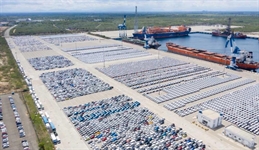
Sri Lanka’s Hambantota International Port (HIP) is optimistic about its future as a key regional multi- purpose port.
What the facility on the island’s east coast (on the Indian Ocean) is pitching for is being a gateway port for light and heavy industrial manufacturing in the surrounding area. That would be highly significant for Sri Lanka and for transhipment services.
The port’s master plan is currently in motion and aims to enhance all its multipurpose operations, including container handling and warehousing – although, in an interview with Asia Cargo News, it was coy about these, reflecting both an uncertain world economy and Sri Lanka’s recent economic woes and the political upheaval caused.
“HIP is promoting not only the port’s operations but also its industrial park to diverse industries from across the globe with a view to creating an international investor community. Apart from the ongoing projects, the port has signed 40 agreements both for the Hambantota Maritime Centre and the Industrial Park,” a HIP representative said.
Balancing this is an awareness that things are not the best at the moment – either globally or in Sri Lanka.
“Global inflation and recession are expected to be the biggest hindrance for businesses in 2023. Along with this will come demand changes and supply chain fluctuations,” the representative said.
“The country’s economic stability and global economic downturn that will impact business are issues that would be challenging,” he added.
This is clearly significant for HIP as the company’s plan is based not on a strict timeline but “will be evolving based on how the global economy moves,” Tissa Wickramasinghe, the port’s chief operating officer, told Asia Cargo News.
“However, our concentration right now is not on time frames; instead, we are wholly focused on developing the wide scope of existing port businesses and the upcoming industrial park. HIP is moving rapidly towards becoming a multipurpose port, and we are providing high-quality, efficient services to our customers along the way,” he added.
Wobbly economies have not deterred the Hambantota sales staff, who have been out there selling hard the introduction of new services, part of an ongoing aggressive marketing plan which appears to be working.
“The port is expected to show significant growth this year, too,” a port official told Asia Cargo News without quantifying the statement.
One detail is how HIP prioritized visiting overseas’ customers for face-to-face meetings once Covid-19 restrictions were removed.
Chinese partners are involved as Hambantota builds up to being a South Asian energy hub where its partner is SINOPEC and in being a more important global facility.
A 17,300 sq metre in-port warehousing complex is expected to become fully operational in the second quarter of this year, 2023, while a plug-and-play, park-in-park facility by Xinji Shenzhen Group will begin operations by the middle of the year, the official; said. A covered, bonded warehousing facility is currently under construction for local distribution and transhipment of fertilizer.
“It will attract new cargo volumes to HIP and contribute to the port’s goal of becoming a regional hub for bulk cargo,” the official said.
In that, it is not alone, as HIP already has its eye on another future sector and country.
“HIP is the newest port in the east-west shipping lanes, which has the ability to grow its capacity in the transhipment of vehicles. Our RORO volumes have grown over the past few years. EVs are the current trend, so we need to make sure we are prepared for them. We have already started setting up charging stations and special towing equipment for EV cargo. Since we have been focusing on benchmarking and meeting industry standards, we need to stay updated on this sector since we have our primary customer base in India,” Bindu Ranasinghe, deputy general manager (commercial and marketing) of HIPG, said at a recent conference.
As for containers? There are some – and the plan is for more – but the plan is also for Colombo to remain the national gateway for containers.
“HIP is currently focusing on RORO/LPG/bunkering/bulk businesses, although the port has handled a few container vessels subject to requirements of our customers, and yes, the Port of Colombo is the main container port in Sri Lanka,” Wickramasinghe told Asia Cargo News.
“Regarding HIP’s future growth plans, container traffic does play a role in our expansion program,” Wickramasinghe added without elaborating.
That written, there is a lot more potential still there as, even without its add-ons, Hambantota is an impressive harbour, one well positioned for global shipping lanes, especially the all-important east-west or Asia-Europe sailings.
The port has a depth of 17m and variable drafts on quaysides but with a minimum maintained depth of 14.5m. In practical terms, the size of ships, as well as type, can take vessels of any size up to and including large tankers.
By Michael Mackey
Southeast Asia Correspondent | Bangkok



